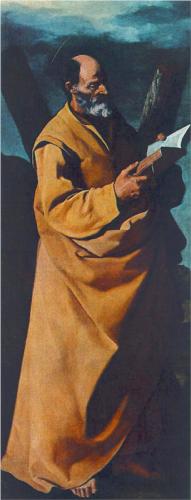Category:Andrew (subject)
Andrew (1st century CE) was one of the Twelve Apostles of Jesus of Nazareth, and the brother of Peter.
<Events : Call of the First Disciples -- Martyrdom of Andrew -- Relics of Andrew>
<Fiction : Andrew (art) -- Andrew (cinema) -- Andrew (literature) -- Andrew (music)>
Overview
Andrew is mentioned only in Christian sources, i.e. in the Gospels of Mark, Matthew, Luke (and Acts), and John, as one of the closest disciples of Jesus. He was the brother of Simon Peter (Mk 1:16; Mt 4:18; Jn 1:40); the son of Jona (Mt 16:17) or John (Jn 1:42); one of the Twelve (Mk 3:18; Mt 10:2; Lk 6:14; Acts 1:13).
The calling of Andrew
According to Mark and Matthew, at the time of his call Andrew was living in Capernaum (Mk 1:21.29); he and Peter were fishing when Jesus called them (Mk 1:16-18 = Mt 4:18-20).
According to the Gospel of John, Andrew was from "Bethsaida" (Jn 1:44) and a former disciple of John the Baptist, before joining the group of the disciples of Jesus. He was "one of the two [disciples] who heard John speak [about Jesus]" (Jo 1:40). They "followed Jesus... and remained with him that day." Andrew then "found his brother Simon [Peter]" and brought him to Jesus, saying: "We have found the Messiah" (Jn 1:35-41).
Andrew the disciple
There are only a few additional references to Andrew in the Gospel traditions.
In the Gospel of Mark, Andrew (with Peter, James, and John) were the disciples, who "on the Mount of Olives... asked [Jesus] privately" about the signs of the end (Mk 13:3); the answer is known as "eschatological discourse" of Jesus (Mark 13).
In the Gospel of John, Andrew is often associated with Philip, who was also "from Bethsaida of Galilee" (Jo 1:44; 12:21) and one of the earliest to follow Jesus (1:43). Andrew is the one who indicated to Jesus "the boy with five barley loaves and two fish" (Jo 6:6), after Philip had given up any hope to feed the crowd. When "some Greeks came to Philip... wishing to see Jesus", it is said that first "Philip went and told Andrew; then Andrew and Philip went and told Jesus" (Jo 12:20-22).
Later Christian traditions
The later Christian tradition made Andrew a preacher in Asia Minor and in Scythia, and the founder of the See of Byzantium. It also tells of his martyrdom on a X-shaped cross at Patras, Greece around 60 CE, following his refusal to worship idols.
In 357 Andrew's purported remains were brought to Constantinople, while his head (except a fragment) remained in Patras. In 1206, during the occupation of Constantinople (Fourth Crusade) the papal legate Cardinal Capuano of Amalfi, transferred those relics in Italy. In 1208 the city of Amalfi welcomed them solemnly in the crypt of their cathedral. When in 1460 the Turks invaded Greece, the head of the Apostle was brought from Patras to Rome; it was kept in St. Peter for five centuries, until Pope Paul VI in 1964 returned the relic to the church of Patras (see Relics of Andrew).
Gabriele Boccaccini, University of Michigan
Andrew, in ancient sources
Gospel of Mark
Mark.1.16 Passing alongside the Sea of Galilee, he saw Simon and Andrew the brother of Simon casting a net into the sea, for they were fishermen.
Mark.1.29 And immediately he left the synagogue and entered the house of Simon and Andrew, with James and John.
Mark.3.18 Andrew, and Philip, and Bartholomew, and Matthew, and Thomas, and James the son of Alphaeus, and Thaddaeus, and Simon the Cananaean,
Mark.13.3 And as he sat on the Mount of Olives opposite the temple, Peter and James and John and Andrew asked him privately,
Gospel of Matthew
Matt.4.18 While walking by the Sea of Galilee, he saw two brothers, Simon (who is called Peter) and Andrew his brother, casting a net into the sea, for they were fishermen.
Matt.10.2 The names of the twelve apostles are these: first, Simon, who is called Peter, and Andrew his brother; James the son of Zebedee, and John his brother;
Gospel of Luke
Luke.6.14 Simon, whom he named Peter, and Andrew his brother, and James and John, and Philip, and Bartholomew,
Gospel of John
John.1.40 One of the two who heard John speak and followed Jesus was Andrew, Simon Peter’s brother.
John.1.44 Now Philip was from Bethsaida, the city of Andrew and Peter.
John.6.8 One of his disciples, Andrew, Simon Peter’s brother, said to him,
John.12.22 Philip went and told Andrew; Andrew and Philip went and told Jesus.
Acts of Apostles
Acts.1.13 And when they had entered, they went up to the upper room, where they were staying, Peter and John and James and Andrew, Philip and Thomas, Bartholomew and Matthew, James the son of Alphaeus and Simon the Zealot and Judas the son of James.
Eusebius, Historia ecclesiastica
III 1,1 -- Scythia, according to tradition, was allotted to Andrew as his field of labor...
Andrew, in the arts
Although a familiar presence in the narratives of the life of Jesus, Andrew has never gained a life of his own in modern fiction, apart from the traditional association with Jesus or his brother Simon Peter.--Gabriele Boccaccini, University of Michigan
- See Andrew (arts) -- survey of fictional works
Andrew in scholarship
- Andrew (research) -- survey of scholarly works
References
- Andrew / Dennis R, MacDonald / In: The Anchor Bible Dictionary (1992 Freedman), dictionary, 1:242-244
Related categories
External links
Pages in category "Andrew (subject)"
The following 4 pages are in this category, out of 4 total.
